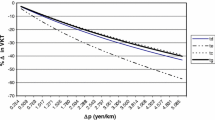Abstract
This paper examines to what extent, if any, natural environmental factors affect consumer purchase decisions regarding “green” products. We collect and combine several unique datasets to study the impact of air pollution on consumers’ choices of passenger vehicles in China. Exploiting cross-city variation, we find that air pollution levels negatively affect the sales of fuel-inefficient cars on average. This relationship, though, is U-shaped over the observed air pollution levels, in that fuel-inefficient car purchases rise with air pollution beyond some threshold. Furthermore, a city’s income level is a significant factor in this non-monotonic relationship, in the sense that consumers of higher-income cities are less likely to suffer this reversal. All these results are consistent with the literature’s theoretical predictions of hope. The rich findings of our study yield important implications to both marketers and policy makers.


Similar content being viewed by others
Notes
As we will discuss, the disparate air quality across Chinese cities is primarily caused by geographical and climatic factors. It is impossible that one individual’s vehicle choice could materially affect the level of air quality, a fact that precludes reverse causality.
In a concurrent survey study that we conducted to complement this research, 64 % of Chinese consumers agree that “issues relating to the environment are very important;” 82 % agree that “Everyone is personally responsible for protecting the environment in their everyday life;” 81 % believe “if all of us, individually, made a contribution to environmental protection, it would have a significant effect;” and 57 % agree that “vehicles are a significant source of air pollution.” The total sample size of the survey is 160. The detailed questionnaire is available from the authors upon request. In addition, a 2008 McKinsey & Company global survey of 7751 consumers in the world’s eight major economies revealed that Chinese consumers are very “green,” ranking no. 1 in the categories of “using energy-efficient appliances” and “driving less/using public transportation more” (Bonini et al. 2008).
A “city” in China is more like a Metropolitan Statistical Area (MSA) than a city or town in the USA.
There are four direct-controlled municipalities (Beijing, Tianjin, Shanghai, and Chongqing). The remaining 269 cities belong to 22 provinces and five autonomous regions (Guangxi, Inner Mongolia, Ningxia, Tibet, and Xinjiang). Our data do not cover China’s two special administrative regions (Hong Kong and Macau) and the territories governed by the Republic of China (R.O.C.), commonly known as Taiwan.
A complete list of the characteristics collected is available from the authors upon request.
In the complementary survey study, 85 % of Chinese consumers understand the meaning of AQI and 77 % pay attention to the AQI reports and updates.
These monthly averages mask the fact that air pollution varies within and across days and therefore substantially understate a city’s air pollution at its worst time on its worst day.
The Chinese government forbids the free movement of people across cities, which ensures that higher-income households moving to less polluted cities are not driving our results.
We henceforth use “brand/model/transmission” and “transmission” interchangeably.
These instruments have sufficient power. Using \( \ln \left(\tilde{s}\right) \) as the dependent variable, a comparison of goodness-of-fit measures without and without the set of IVs yields an F-stat of 151.61, well above the 99 % confidence threshold of 2.41.
References
Berry, S. T. (1994). Estimating discrete-choice models of product differentiation. RAND Journal of Economics, 25(2), 242–262.
Berry, S. T., & Waldfogel, J. (1999). Free entry and social inefficiency in radio broadcasting. RAND Journal of Economics, 30(3), 397–420.
Bonini, S., Hintz, G., & Mendonca, L. (2008). Addressing consumer concerns about climate change. McKinsey Quarterly.
Chen, Y., Jin, G. Z., Kumar, N., & Shi, G. (2013). The promise of Beijing: evaluating the impact of the 2008 Olympic Games on air quality. Journal of Environmental Economics and Management, 66(3), 424–443.
Einav, L. (2007). Seasonality in the U.S. motion picture industry. RAND Journal of Economics, 38(1), 127–145.
Goldstein, N. J., Cialdini, R. B., & Griskevicius, V. (2008). A room with a viewpoint: using social norms to motivate environmental conservation in hotels. Journal of Consumer Research, 35(3), 472–482.
Hardin, G. (1968). The tragedy of the commons. Science, 162(3859), 1243–1248.
Kotler, P. (2011). Reinventing marketing to manage the environmental imperative. Journal of Marketing, 75(4), 132–135.
Lloyd, W. F. (1833). Two lectures on the checks to population. Available on Google Books.
MacInnis, D. J., & de Mello, G. (2005). The concept of hope and its relevance to product evaluation and choice. Journal of Marketing, 69(1), 1–14.
Mazar, N., & Zhong, C. B. (2010). Do green products make us better people? Psychological Science, 21(4), 494–498.
Author information
Authors and Affiliations
Corresponding author
Additional information
The authors are grateful for the helpful comments from the editor and the two referees. This paper has also benefited from the feedback of Devon DelVecchio, Joseph Goodman, Manu Kalwani, Shibo Li, and Bill Robinson and comments of attendees of the 2014 Marketing Science Conference.
Rights and permissions
About this article
Cite this article
Li, J., Moul, C.C. & Zhang, W. Hoping grey goes green: air pollution’s impact on consumer automobile choices. Mark Lett 28, 267–279 (2017). https://doi.org/10.1007/s11002-016-9405-2
Published:
Issue Date:
DOI: https://doi.org/10.1007/s11002-016-9405-2




